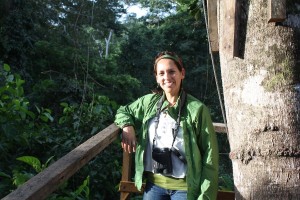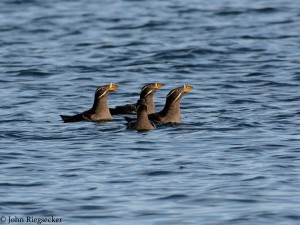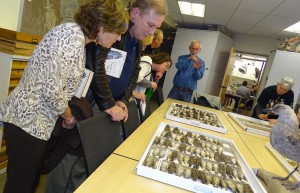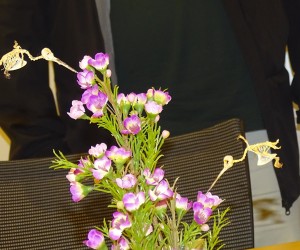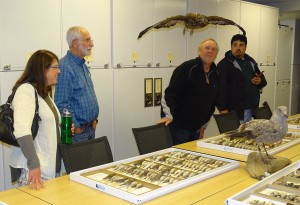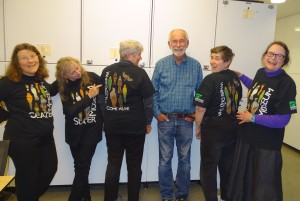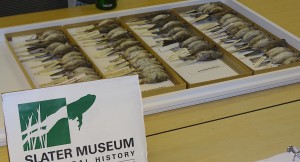ABC SHRUB-STEPPE FIELD TRIP, APRIL 10, 2016
They don’t call Andy Stepniewski “Steppie” for nothing, as he is a foremost authority on Shrub-Steppe habitats in the northwest. Andy and his wife Ellen met us at 6:30 a.m. Sunday morning after we’d all had exciting treks eastward on Saturday. Amazingly, we had a blazing sunrise and perfect weather! None of that wind Andy had forebodingly warned us about.
With most of us westerners just enjoying our first spring birds in early April, it was interesting to hear Andy tell us that on the Shrub-Steppe, all the action is March through May, with summer and winter quiet times for birds as well as vegetation. He quoted Dennis Paulson who said something along the lines of, “There is no place so dead in Washington in the wintertime as the Shrub-Steppe.”
The wildflowers and of course those all-important bunchgrasses, of which there are a bunch, were studied in depth in person. More information on these plants and habitats is to be found in, “Birds of Yakima County, 2nd Edition,” by Andy, of course. It’s available from Yakima Valley Audubon on their website:
http://yakimaaudubon.org/wp-content/uploads/sites/6/2015/08/Birds-of-Yakima-County.doc.pdf
Even though Andy operates out of Yakima County, the Shrub-Steppe does not obey artificial county bounds, so the field trip spent lots of time in Kittitas and Grant counties, visiting several well-known hot spots as well as some unknown sites to some of us.
Besides bunchgrasses and flowers, sagebrush and its look-alikes are king. Andy had us smell and taste the leaves of a sage and a bitterbrush to bring us into the zone. View some of his comments on the FLICKR site below. Moviette was too large to load here.
As for birds, a few of us were thrilled to be birding east of the mountains BEFORE the arrival of those nasty empidonax flycatchers who live to confuse us. Most of our expected and desired species were seen, with particularly thrilling looks and listens at Long-billed Curlew, Wilson’s Snipe, Sandhill Crane, Black-necked Stilt, and COPULATING American Avocets! Other exciting birds included White-throated Swifts, Great Horned Owl, Loggerhead Shrike, Mountain Bluebirds, Horned Larks, and of course those Shrub-Steppe specialties, Sagebrush Sparrow, Brewer’s Sparrow, and Sage Thrasher, seen and heard well. The soundtrack for the day was provided by Vesper Sparrows and Western Meadowlarks. Feasts for eyes and ears!
The flowers were mostly elfin, and some of them grew in bunches, looking like bouquets! Ellen was frequently taken aside by the botanizers among us, and flowers were ID’d and photographed. Those people who stand tall miss so much at toe height! With Ellen being an expert in this field, those two Stepniewskis make quite a power couple.
Special thanks goes to Kay Pullen who helped pull this field trip together along with the sparrow workshops with Dennis Paulson earlier in the week. Then she kept track of all the species for eBird, too!
Many photos were taken. Laurel and Heather will put links to their photos in the Comments section of this site when they’ve had a chance to edit them. Anyone else who wants to share photos is encouraged to do this, also, such as Richard. Diane’s photos are on FLICKR at:
https://www.flickr.com/photos/76552838@N03/albums/72157664855173204
Our ABC group as pictured here at the Ginkgo SP Interpretative Center included:
SITTING: ELLEN STEPNIEWSKI, Petrea, Kathy, Faye, Laurel, Donna.
STANDING: Ken, Carolyn, Richard in hat, Ted, Mary, Mike, ANDY STEPNIEWSKI, Carol, Jody, Heather, Ryan, Kay, Diane.
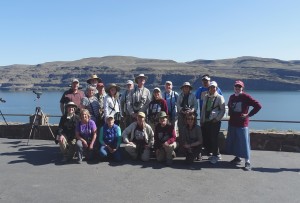
Shrub-steppe field trip, April 10, 2016. Taken at Ginkgo SP.
As an aside, just a couple of weeks ago, the local newspaper did a story on Andy, and it’s pretty thrilling, as well as informative (thanks to Heather for providing the link):
http://www.yakimaherald.com/news/survivor-bear-attack-redefined-how-he-lives-his-life-but/article_d24da4d2-f3e2-11e5-8549-3fbdea3d5b30.html

